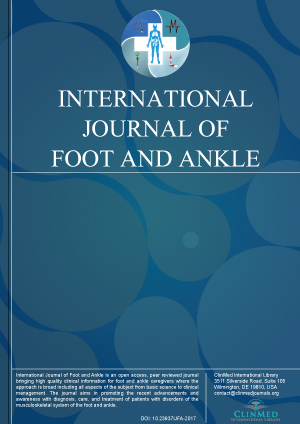Open Access DOI:10.23937/2643-3885/1710029
Z-Calcaneal Osteotomy: Radiographic Assessment of Correction in the Valgus Hindfoot
Daniel Dawson, A Walls and J Wong
Article Type: Original Article | First Published: June 24, 2019
Elective reconstruction in the valgus hindfoot is a complex and varied field of orthopaedic surgery. Often multiple procedures, both bony and soft tissue are required. The surgical aims are to create a plantigrade foot, restore hindfoot alignment and re-create the medial longitudinal arch in an attempt to allow more normal biomechanical function. Invariably a calcaneal osteotomy is required to correct hindfoot alignment. There are various methods of performing a calcaneal osteotomy....
Open Access DOI:10.23937/ijfa-2017/1710028
Changes in Dynamic Plantar Pressure for Children with Tarsal Coalition as Compared to Normal Children
Brian Curtin, DO, Xue-Cheng Liu, MD, PhD, Roger Lyon, MD and Scott Van Valin, MD
Article Type: Research Article | First Published: May 10, 2019
One of effective therapeutic treatment involves the use of inserts to alter the foot biomechanical alignment and reduce the pain. It is essential to select an appropriate insert based upon foot functions by dynamic plantar pressure measurements. The goal of this study was to evaluate children's kinetic abnormalities in feet with tarsal coalition using plantar pressure measurements. The design of this study was a prospective cohort with normal control, which is considered as Level 3 Evidence....
Open Access DOI:10.23937/ijfa-2017/1710027
Extracorporeal Shock Wave Therapy (ESWT) for Refractory Fractures at the Fifth Metatarsal Base
Kenta Tanaka, Akihiro Kanamori, Masaya Kajiwara, Tomofumi Nishino, Yusuke Nishida, and Masashi Yamazaki
Article Type: ORIGINAL ARTICLE | First Published: March 22, 2019
A fifth metatarsal base fracture is common in athletes and is often difficult to treat. Refractory cases are often managed surgically with screw fixation or bone grafts, but such procedures are extremely invasive. Recently, positive results have been reported from the use of extracorporeal shock wave therapy (ESWT) for stress fractures or delayed fracture union. We report on our experience with ESWT used in five cases of refractory fifth metatarsal base fracture where bone union had not been ach...
Open Access DOI:10.23937/ijfa-2017/1710026
Mitchell Osteotomy for Hallux Valgus Using Trans-Osseous Capsulorrhaphy for Stabilization
Adnan A Faraj FRCS (Orth)
Article Type: Research Article | First Published: March 20, 2019
The fixation method of Mitchell's osteotomy after displacement is controversial. In the current study, we evaluated a previously described technique of using transosseous capsulorrhaphy. In this series, foot plaster slipper was used for six weeks. Twenty-seven feet (21 patients) underwent the technique for symptomatic hallux valgus was included in this study. Retrospective and consecutive series. Mitchell's step cut osteotomy was performed without metal fixation, trans osseous capsulorrhaphy was...
Open Access DOI:10.23937/ijfa-2017/1710025
Diffusion Weighted Magnetic Resonance Imaging of the Achilles tendon and Related Pathology: Qualitative & Quantitative Investigation
Muna Al Mulla, PhD, Allison McGee, MSc, Prof. Stephen Eustace, and Louise Rainford, PhD
Article Type: RESEARCH ARTICLE | First Published: February 28, 2019
Diffusion-weighted imaging (DWI) is an MRI technique that has shown to be a very promising in facilitating the differentiation of subtle pathological changes within different tissue. However, to date, a conclusive physical basis for the signal contrast on DWI of the Achilles tendon (AT) is yet to be available in literature. The purpose of this work is to evaluate the diagnostic impact of echo planar DWI in distinguishing normal and abnormal AT using ADC mapping as a qualitative and quantitative ...
Open Access DOI:10.23937/ijfa-2017/1710024
The Role of Interfragmentary Compression Screw on Union Rates and Shortening of the First Ray in Lapidus Arthrodesis: A Comparative Study
Andre Busch, Marcus Jager, Florian Dittrich, Andre Sander, Stephanie Herbstreit and Sascha Beck
Article Type: ORIGINAL ARTICLE | First Published: February 18, 2019
Hallux valgus (HV) is a common deformity of the forefoot in which a deviation of the first metatarsophalangeal joint arises. HV has been described to be characterized by a number of structural factors including radiographic angles, metatarsal length, metatarsal head shape, sesamoid position, first metatarsocuneiform joint flexibility and pes planus. The etiology is not fully resolved. However, HV is associated with gender, age and family history. Moreover, it is limited to shoe-wearing cultures ...
Open Access DOI:10.23937/ijfa-2017/1710023
Calcifying Tendonitis of the Ankle, Effectivenness of 5% Acetic Acid Iontophoresis and Ultrasound over Achiles Tendon: A Prospective Case Series
Marcos E Fernandez-Cuadros, Olga S Perez-Moro, Maria Jesus Albaladejo-Florin, Ruben Algarra-Lopez and Luz Casique-Bocanegra
Article Type: Prospective Case Series | First Published: February 13, 2019
To conduct a prospective Multicentre Quasi-experimental before-and-after study (Non-Randomized Control Trial) to demonstrate the effectiveness of Acetic Acid Iontophoresis and Ultrasound in the treatment of Calcifying Tendonitis (CT) of the ankle. Prospective, multicentre, quasi-experimental before-after intervention study, to 10 patients who attended to both Rehabilitation Departments, at Santísima Trinidad's General Foundation Hospital, Salamanca-Spain and at Santa Cristina's University Hospi...
Open Access DOI:10.23937/ijfa-2017/1710022
MRI Diagnosis of Accessory Soleus Muscle: A Case Report and Review of the Literatures
Jun Zhang, Dapeng Hao, Chuanyu Zhang and Shaohua Wang
Article Type: Case Report | First Published: February 13, 2019
The accessory soleus muscle is a rare anatomical variant that usually occurs in adolescents or young adults. And it may manifest as an exertional ankle pain and swelling or as an asymptomatic posteromedial mass. However sometimes it may be mistaken as a soft tissue tumor at the ankle. The purpose of this study is to heighten awareness about the existence of accessory soleus muscle in a swelling at the posteromedial aspect of the ankle and to reduce the failure to recognize this muscle in MRI....

